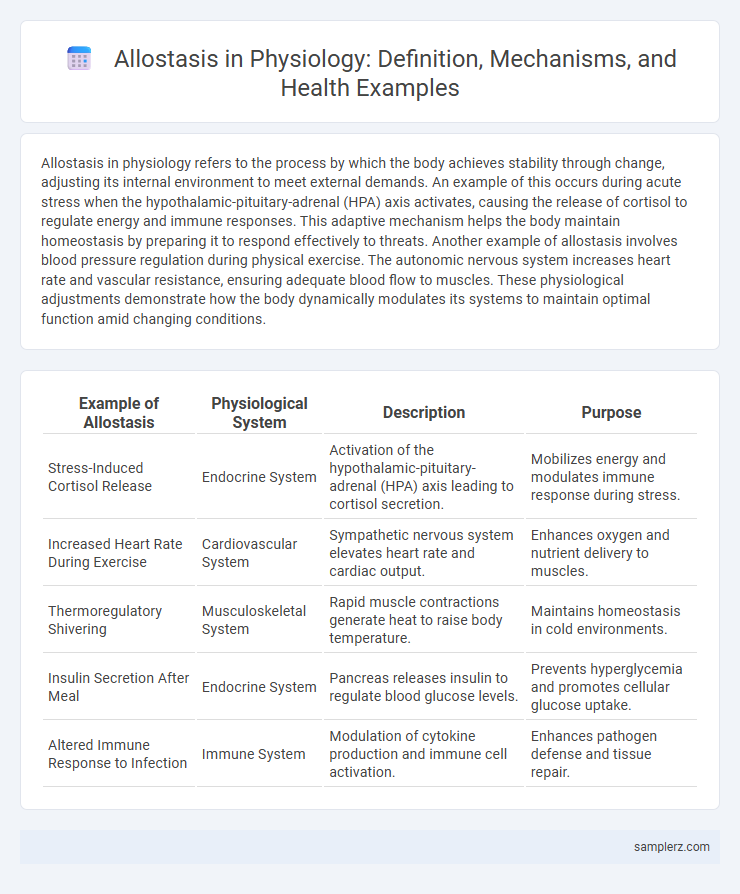Allostasis in physiology refers to the process by which the body achieves stability through change, adjusting its internal environment to meet external demands. An example of this occurs during acute stress when the hypothalamic-pituitary-adrenal (HPA) axis activates, causing the release of cortisol to regulate energy and immune responses. This adaptive mechanism helps the body maintain homeostasis by preparing it to respond effectively to threats. Another example of allostasis involves blood pressure regulation during physical exercise. The autonomic nervous system increases heart rate and vascular resistance, ensuring adequate blood flow to muscles. These physiological adjustments demonstrate how the body dynamically modulates its systems to maintain optimal function amid changing conditions.
Table of Comparison
| Example of Allostasis | Physiological System | Description | Purpose |
|---|---|---|---|
| Stress-Induced Cortisol Release | Endocrine System | Activation of the hypothalamic-pituitary-adrenal (HPA) axis leading to cortisol secretion. | Mobilizes energy and modulates immune response during stress. |
| Increased Heart Rate During Exercise | Cardiovascular System | Sympathetic nervous system elevates heart rate and cardiac output. | Enhances oxygen and nutrient delivery to muscles. |
| Thermoregulatory Shivering | Musculoskeletal System | Rapid muscle contractions generate heat to raise body temperature. | Maintains homeostasis in cold environments. |
| Insulin Secretion After Meal | Endocrine System | Pancreas releases insulin to regulate blood glucose levels. | Prevents hyperglycemia and promotes cellular glucose uptake. |
| Altered Immune Response to Infection | Immune System | Modulation of cytokine production and immune cell activation. | Enhances pathogen defense and tissue repair. |
Introduction to Allostasis in Human Physiology
Allostasis in human physiology refers to the process by which the body achieves stability through change by adjusting physiological parameters to meet stress demands. For example, during physical exercise, the cardiovascular and respiratory systems increase heart rate and oxygen delivery to maintain homeostasis despite increased energy requirements. This adaptive mechanism enables the body to anticipate and efficiently respond to fluctuating internal and external stressors, maintaining overall health and function.
Allostasis vs. Homeostasis: Key Differences
Allostasis in physiology refers to the process by which the body achieves stability through change by actively adapting to stressors, unlike homeostasis, which maintains internal balance through fixed set points. For example, during exercise, allostasis regulates heart rate and hormone levels to meet increased energy demands, while homeostasis maintains baseline conditions like body temperature. This dynamic adaptation under allostasis allows the body to anticipate and prepare for future challenges, reflecting a more flexible and predictive regulatory system compared to the reactive nature of homeostasis.
The Role of Allostasis in Stress Response
Allostasis in physiology refers to the process by which the body achieves stability through change, particularly during stress by activating the hypothalamic-pituitary-adrenal (HPA) axis and releasing cortisol. This adaptive mechanism maintains homeostasis by regulating cardiovascular, metabolic, and immune functions to meet environmental demands. Chronic activation of allostasis can lead to allostatic load, increasing the risk of hypertension, diabetes, and immune dysfunction.
Cardiovascular Adjustments as Allostatic Processes
Cardiovascular adjustments exemplify allostatic processes by dynamically regulating heart rate and blood pressure in response to physiological stressors. These changes maintain homeostasis through neuroendocrine activation, such as sympathetic nervous system stimulation and cortisol release, enabling efficient oxygen delivery during physical activity or emotional stress. Chronic overactivation of these allostatic responses can lead to hypertension and increased cardiovascular disease risk.
Allostasis in Glucose Regulation and Metabolism
Allostasis in glucose regulation involves the adaptive mechanisms by which the body maintains energy balance under varying physiological conditions, including stress and fasting. The hypothalamic-pituitary-adrenal (HPA) axis modulates cortisol release, which influences gluconeogenesis and insulin sensitivity to stabilize blood glucose levels. Dysregulation of allostatic processes in glucose metabolism can contribute to metabolic disorders such as type 2 diabetes and insulin resistance.
Neuroendocrine System Adaptations and Allostasis
Allostasis in physiology exemplifies how the neuroendocrine system adapts to maintain stability through dynamic changes in hormone release, such as cortisol and adrenaline, during stress. These neuroendocrine adaptations regulate energy distribution, immune function, and cardiovascular responses to meet environmental demands. Chronic activation of allostatic mechanisms can lead to wear and tear, impacting health outcomes like hypertension or metabolic disorders.
Allostatic Mechanisms in Immune Function
Allostatic mechanisms regulate immune function by adapting physiological responses to stress, ensuring homeostasis during immune challenges. The hypothalamic-pituitary-adrenal (HPA) axis modulates cytokine production, balancing pro-inflammatory and anti-inflammatory signals to maintain immune equilibrium. Chronic activation of these allostatic processes can lead to immune dysregulation, increasing susceptibility to infections and autoimmune disorders.
Sleep-Wake Cycle: An Allostatic Perspective
The Sleep-Wake Cycle exemplifies allostasis by dynamically adjusting physiological processes to maintain stability amid environmental and internal changes. Cortisol secretion and melatonin production fluctuate in anticipation of sleep and wake periods, optimizing energy use and cognitive function. This regulatory flexibility supports overall health by preventing chronic stress effects and promoting restorative sleep.
Chronic Stress and the Concept of Allostatic Load
Chronic stress triggers prolonged activation of the hypothalamic-pituitary-adrenal (HPA) axis, leading to sustained cortisol release that exemplifies the concept of allostasis in physiology. The cumulative wear and tear on the body's systems due to this persistent stress response is termed allostatic load, which increases the risk of cardiovascular disease, metabolic syndrome, and cognitive decline. Monitoring biomarkers like cortisol levels, blood pressure, and inflammatory cytokines helps quantify allostatic load and guide interventions to restore physiological balance.
Clinical Implications of Allostasis in Healthcare
Allostasis, the process by which the body achieves stability through physiological change, plays a critical role in managing stress responses and maintaining homeostasis. In clinical settings, understanding allostatic load--the cumulative wear and tear on the body from chronic stress--helps healthcare providers predict risks for conditions such as hypertension, cardiovascular disease, and metabolic syndrome. Targeting allostatic mechanisms in treatment plans can improve patient outcomes by reducing stress-induced physiological damage and promoting adaptive resilience.

example of allostasis in physiology Infographic
 samplerz.com
samplerz.com